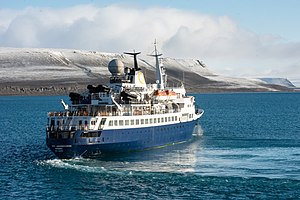Engineering:MV Sea Adventurer
 Expedition ship, MV Ocean Adventurer, weighs anchor to depart from Beechey Island, Nunavut, Canada.
| |
| History | |
|---|---|
| Name: |
|
| Owner: | International Shipping Partners |
| Port of registry: |
|
| Builder: | Brodogradilište 'Titovo', Kraljevica, Yugoslavia SFR Yugoslavia (now Croatia) |
| Yard number: | 408 |
| Launched: | 19 April 1975 |
| In service: | 1975 |
| Identification: |
|
| Status: | In service |
| General characteristics (Refitted in 2017) | |
| Class and type: | Maria Yermolova-class passenger ship |
| Tonnage: | 4,376 tons[1] |
| Length: | 100.58 m (330.0 ft) |
| Beam: | 16.31 m (53.5 ft) |
| Draught: | 4.72 m (15.5 ft) |
| Decks: | 6 |
| Ice class: | 1A |
| Propulsion: |
|
| Speed: | 12 knots |
| Capacity: | 128 |
| Crew: | 87 |
M/V Ocean Adventurer[2] is an ice-capable expedition cruise ship operating commercial voyages to both polar regions, with Quark Expeditions of Seattle, WA, USA. The vessel was renamed as Sea Adventurer on 1 October 2012, having previously been registered as Clipper Adventurer. She is the sister ship to the MV Lyubov Orlova. Built in 1975 in the former Yugoslavia as Alla Tarasova, she underwent a $13 million refit in 1998 managed by Master Mariner AB, Sweden.
During the summer of 2009 Adventure Canada of Mississauga, Ontario, Canada carried passengers through the Northwest Passage on the Clipper Adventurer.
On 27 August 2010, Clipper Adventurer ran aground of a supposedly uncharted rock in the waters of Nunavut's Coronation Gulf during a cruise. The collision damaged the ship's ballast and fuel tanks, leading pollution to be released into the Coronation Gulf. 128 passengers and 69 crew members were stranded until they were rescued by the CCGS Amundsen.[3] It was later found that the rock was indeed a known hazard and had already been properly reported by the Canadian Hydrographic Service.[4][5]
The salvage job was awarded to Resolve Marine Group, a Florida-based Salvage company.[6] On 18 September 2010, the ship was successfully towed into Cambridge Bay.
External links
References
- ↑ Equasis
- ↑ Quark Expeditions
- ↑ Mooney, Chris (21 December 2017). "Scientists came to explore the fabled waters of the Arctic — but their work could also change its future.". Washington Post. https://www.washingtonpost.com/graphics/2017/business/mapping-arctic-waters/?tid=a_inl. Retrieved 4 January 2018.
- ↑ Nunatsiaq Online (September 2010). "Clipper Adventurer ran into a charted hazard expert says". http://www.nunatsiaqonline.ca/stories/article/0409102_clipper_adventurer_ran_into_a_charted_hazard_expert_says/. Retrieved 2010-09-04.
- ↑ CBC News (August 2010). "Cruise ship stranded in Nunavut". http://www.cbc.ca/canada/north/story/2010/08/29/north-cruise-ship-stranded.html. Retrieved 2010-08-29.
- ↑ Marine Log (September 2010). "Resolve Marine Group starts Clipper Adventurer salvage". http://www.marinelog.com/DOCS/NEWSMMIX/2010sep00033.html. Retrieved 2010-09-03.
 |

